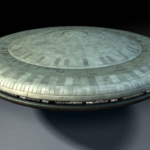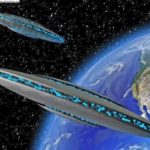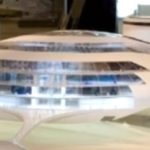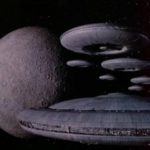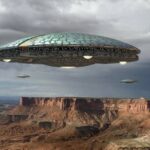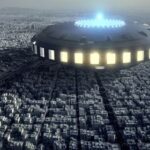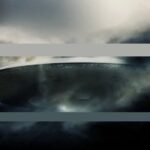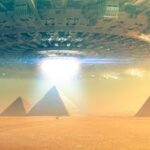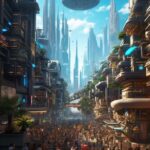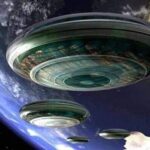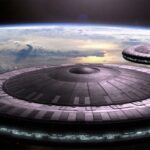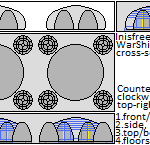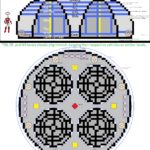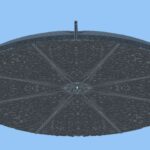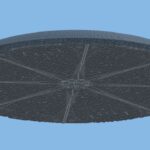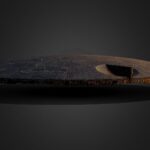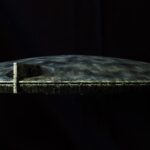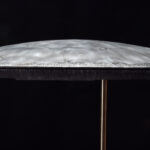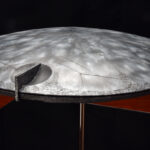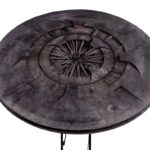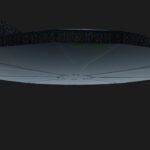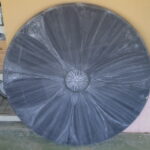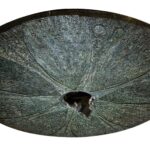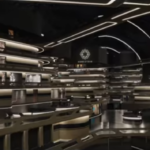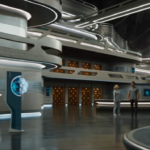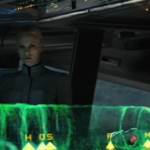If you see one of these ships, it is likely arriving to rapidly change an entire landscape or build a whole city.
–
Table of Contents:
- Introduction
- Use
- Dimensions & Complement
- (Former) Vertical Layout & Primary Inventory Items
- Total Complement
- Repulsines
- Capabilities
- Appearance Modes
- Terraforming Process
- Time to Construct
- History
- Additional Notes: Amenities
- Overall Appearance (Images Begin)
- Design
- Comparisons
- Interior Concepts
- The ‘Living Throne’ of ICVs in the Cockpit
- Helping Humans Make Way
–
Introduction:
Like the frisbee-shaped Spaceships of Independence Day (the film), these Inisfreean versions are giant, town-sized vessels capable of destroying entire cities if need be, as well as dropping off multiple armies of troops, vehicles, and aircraft. Their original function was to convert whatever they hovered over into a new and growing colony of their kind, thus their name; ColonyPods. Anytime you see “CP”, that is our abbreviation for one of these colony-starting spaceships.
–
Use:
This type of Inisfreean construct will be deployed whenever there is warfare on the nation or sea level, and whenever the Inisfreean terraforming style called ‘gridding’ is desired (1 CP typically ‘grids’ a nation- or sea-sized area, but can ‘grid’ an entire world over the course of years, though that is usually tasked to hundreds of CPs or more).
..
2024 October note: Grid-ing isn’t ruining or warring against nature; it is a sign of the era when it is time to clean away the pole-shift debris, as well as the bad/false humans who weren’t meant to survive the previous cataclysm/s.
–
Dimensions & Complement:
Every Colony Pod contains four Inisfreean Dropships within it (which deploy from hangars on the Colony Pod’s underside). Even when all four of these towering delivery vessels are detached and deployed, however, each Colony Pod still houses an entire army of personnel, vehicles, and aircraft.
- Diameter: 3,960′ (at the lowest hangar level)
- Height: 25pxl tall = 1,650′ (25×66)
- Floorspace: 12,316,299 sqft. (for the widest levels)
- Stories: ~80 (excluding the tallest levels used for the IC BMs)
- Upper Levels: ~20 (excluding the tallest levels used for the IC BMs, and the 120′-tall level for the landing gear) (assuming some levels are 2-3 stories; 20′-30′ for the WRs and MPHAs, etc.)
- Total Floorspace: ~246,325,980 sqft. (12,316,299 x 20 levels)
- Personnel: 3,125,000 IC MFs
- Dispersion: ~1 IC MF per 78 sqft.; ~1 IC MF per 9’x9′ area (246,325,980 sqft. / 3,125,000 IC MFs) if evenly dispersed
- Overall Layout: radial; 4 subdivisions/hangars per level, all arranged evenly around a central cluster of AIOWs
Main Sections:
- double-hull; even if the outer hull was breached/penetrated, it would not depressurize any hangars (which don’t have atmospheres/pressure, anyway; ICVs and other ICs don’t need them)
- big-ship hangars; for the 4 DSs (and all 4 of these hangars are double-hull like the whole CP)
- repulsines; ~200′ diameter (the size of an average stadium, if sphered)
- floors for rooms/suites and smaller craft; 70 floors/levels of them, all connected by 4 BM-sized/wide service-lifts (elevators)
Every floor is connected to the other floors via service-lifts; at 4 locations.
Every floor has hallways (which are all wide enough for 2 human-sized people walking side by side; hallways are ~5′ wide) connecting/separating its hangars and/or suites.
Hangars on all floors are aligned in a grid, keeping uniform rows and columns all the way along between opposite sides of the CP. While no IC vehicle requires this alignment (as all of them can portal themselves), this facilitates easy traversing if ever a situation calls for no portal-ing; hangar doors can be opened to allow the craft/vehicles inside to drive or hover out… until they are, for example, at a service-lift or outer/external hatch.
Sections/Groups of Floors:
- Command/Cockpit & Kajirae floors; where the cockpit is, and where suites (each of which includes an automated container-farm room/annex; so every passenger has a lifetime anytime-access supply of fresh healthy vegan food) for passengers are
- FJ Hangars floors; where the IC fighter-jets are serviced
- MPHA Hangars floors; where most of the IC cargo-airships are serviced
- ICV floors; where most of the troops ‘rest’ in stasis (tubes)
- TK Hangars floors; where most of the IC tanks are serviced
- WR Hangars floors; where most of the IC APCs are serviced
- BM Hangars floors; where the IC battlemechs are serviced, and where the (~400′-tall) waterfalls are (1 per BM-hangar (thus 16 total in each CP), always where the BM is facing, only flowing when a non-ICV passenger/guest wants to visit one of these hangars, and only visible when that hangar’s visible-spectrum lights are turned on)
- Bombardment floors; for the BMs to enter/exit directly to their pads/stations in the section above it (and this section is called Orbital Bombardment because it is the one almost always facing the planet being orbited, thus it is where the most Inisfreean craft/forces deploy/release from –at least before it makes landfall)
Floors by Section:
- Command & Kajirae: 12 pixels; ~108′; 12 ~9′ floors (tall enough for ICVs and FJs)
- FJs: 12 pixels; ~108′; 12 ~9′ floors (tall enough for ICVs)
- MPHAs: 12 pixels; ~108′; 3 ~36′ floors (for 30′-tall craft)
- TKs: 12 pixels; ~108′; 6 ~18′ floors
- WRs: 12 pixels; ~108′; 6 ~18′ floors
- BMs: 54 pixels; ~493′; 1 500′ floor that extends ~30′ down only beneath each BM pad/station (tall enough for TKs, WRs, and MPHAs)
- Bombardment: 18 pixels; ~164′; 18 ~9′ floors (tall enough for ICVs and FJs)
- Total Floors: 70
Floorspace and DS Hangar-space by Section:
format: [(CP-diameter (-10′ for the double-hull) on that level) – 4(DS-diameter on that level)]
- Cockpit: 782′-diameter = 480,000 sq.ft.
- FJs: 1,838′-diameter = 2,650,000 sq.ft.
- MPHAs: 2,498′-diameter – (~568′-diameter circle x 4) = 4,900,000 – (253,000 x 4) = 4,900,000 – 1,012,000 = 3,888,000 sq.ft.
- ICVs: 3,158′-diameter – (~832′-diameter circle x 4) = 7,830,000 – (544,000 x 4) = 7,830,000 – 2,176,000 = 5,654,000 sq.ft.
- TKs: 3,422′-diameter – (~964′-diameter circle x 4) = 9,200,000 – (730,000 x 4) = 9,200,000 – 2,920,000 = 6,280,000 sq.ft.
- WRs: 3,686′-diameter – (~1,096′-diameter circle x 4) = 10,700,000 – (943,000 x 4) = 10,700,000 – 3,772,000 = 6,928,000 sq.ft.
- BMs: 3,950′-diameter – (~1,360′-diameter circle x 4) = 12,300,000 – (1,450,000 x 4) = 12,300,000 – 5,800,000 = 6,500,000 sq.ft.
- Bombardment: 3,950′-diameter – (~1,360′-diameter circle x 4) = 12,300,000 – (1,450,000 x 4) = 12,300,000 – 5,800,000 = 6,500,000 sq.ft.
Floorspace by Section:
- Cockpit: 480,000 sq.ft. x 12 floors = 5,760,000 sq.ft. available (not used by a DS hangar) for vehicles/personnel
- FJs: 2,650,000 sq.ft. x 12 floors = 31,800,000 sq.ft. available (not used by a DS hangar) for vehicles/personnel
- MPHAs: 3,888,000 sq.ft. x 3 floors = 11,664,000 sq.ft. available (not used by a DS hangar) for vehicles/personnel
- ICVs: 5,654,000 sq.ft. x 12 floors = 67,848,000 sq.ft. available (not used by a DS hangar) for vehicles/personnel
- TKs: 6,280,000 sq.ft. x 6 floors = 37,680,000 sq.ft. available (not used by a DS hangar) for vehicles/personnel
- WRs: 6,928,000 sq.ft. x 6 floors = 41,568,000 sq.ft. available (not used by a DS hangar) for vehicles/personnel
- BMs: 6,500,000 sq.ft. x 1 floors = 6,500,000 sq.ft. available (not used by a DS hangar) for vehicles/personnel
- Bombardment: 6,500,000 sq.ft. x 18 floors = 117,000,000 sq.ft. available (not used by a DS hangar) for vehicles/personnel
- Total Floorspace: 319,820,000 sq.ft.
Individual Craft/Vehicle Floorspace Needs:
- ICV: 9 sq.ft. (3′ x 3′)
- FJ: 600 sq.ft. (20′ x 30′; ~5′ on all sides)
- MPHA: 9,900 sq.ft. (90′ x 110′; ~5′ on all sides)
- TK: 800 sq.ft. (20′ x 40′; ~5′ on all sides)
- WR: 1,500 sq.ft. (25′ x 60′; ~5′ on all sides)
- BM: 18,400 sq.ft. (115′ x 160′; ~20′ on all sides)
Total Craft/Vehicle Floorspace Needs:
- ICVs: 9 sq.ft. x 3,125,000 ICVs = 28,125,000 sq.ft. needed for all ICVs (of 67,848,000 sq.ft. available; 39,723,000 sq.ft. surplus throughout these ~9′-tall floors)
- FJs: 600 sq.ft. x 16,665 FJs = 9,999,000 sq.ft. needed for all FJs (of 31,800,000 sq.ft. available; 21,801,000 sq.ft. surplus throughout these ~9′-tall floors)
- MPHAs: 9,900 sq.ft. x 4,160 MPHAs = 41,184,000 sq.ft. needed for all MPHAs (of 11,664,000 sq.ft. available –thus the remaining needed 29,520,000 sq.ft. is in the BMs section)
- TKs: 800 sq.ft. x 83,330 TKs = 66,664,000 sq.ft. needed for all TKs (of 37,680,000 sq.ft. available –thus the remaining needed 28,984,000 sq.ft. is in the BMs section)
- WRs: 1,500 sq.ft. x 41,650 WRs = 62,475,000 sq.ft. needed for all WRs (of 41,568,000 sq.ft. available –thus the remaining needed 20,907,000 sq.ft. is in the BMs section)
- BMs: 18,400 sq.ft. x 16 BMs = 294,400 sq.ft. needed for all BMs (of 6,500,000 sq.ft. available; 6,205,600 sq.ft. surplus on this floor)
Non-BM subset-floors to add to the BMs section:
- for MPHAs: 29,520,000 / 6,205,600 = 5 36′-tall floors; 180′
- for TKs: 28,984,000 / 6,205,600 = 5 18′-tall floors; 90′
- for WRs: 20,907,000 / 6,205,600 = 4 18′-tall floors; 72′
- Total Vertical: 342′ (in this 493′ floor/space); plenty of room to add these floors within the BMs’ floor
Resulting Vehicles Placement by Section:
- Cockpit: none
- FJs: FJs
- MPHAs: MPHAs
- ICVs: ICVs
- TKs: TKs
- WRs: WRs
- BMs: BMs, plus TKs, WRs, MPHAs
- Bombardment/Landing: none
–
(Former) Vertical Layout & Primary Inventory Items:
Like our DSs, we tended to keep each type of subordinate craft/vehicle in its own group of levels, always based on available floorspace, in this type of ship (our CP), arranged around its 4 largest hangars (for the 4 DSs it transports). In other words, some of the following sections will instead have a different vehicle stored in them, such as MPHAs on a lower or higher level, for example, always based on the most-efficient use of available space.
- Top level: cockpit (7 IC MFs on living thrones made of 3D Celtic-style weaves of IC MFs; ~77 IC MFs total)
- Higher section: FJs (33,330 IC MFs inside 16,665 IC FJs)
- High section: MPHAs (216,320 IC MFs inside 4,160 IC MPHAs)
- Middle section: STs (1,953,125 IC MFs; 5 of our Divisions, the same as are transported in one of our DSs)
- Low section: TKs (499,980 IC MFs inside 83,330 IC TKs)
- Lower section: WRs (749,700 IC MFs inside 41,650 IC WRs)
- Lowest hangars: BMs (3,088 IC MFs inside 16 IC BMs)
- Bottom section: landing gear, etc.
77 + 33,330 + 216,320 + 1,953,125 + 499,980 + 749,700 + 3,088 = 3,455,620 ICVs in each CP
(and this does not count the ICVs in the 4 DSs each CP contains)
Why does a CP, so much larger than a DS, only carry the same number of non-vehicle ICVs (Infantry) as a DS? Most of the space in a CP is for the 4 DS-hangars, and for the main weapon, with a lot of the remaining space taken up by the CP’s repulsines. Since it carries 4 DSs, those are what focus on setting up a secure perimeter/territory; it does not have to rely as much on its own forces/personnel for such, instead often/typically tasking its own personnel with assisting in the forming and patrolling of any city it may be commanded to create.
–
Total Complement: 3,455,620 troops; 625 of our battalions, 83,330 tanks, 41,650 APCs, 16,665 fighter-jets, 4,160 cargo aircraft, and 16 BattleMechs
–
Repulsines:
These devices, in this type/size of IC/vessel, are ~200′ in diameter (the size of a baseball diamond (without the outfield) or ~half a football field/track).
–
Capabilities:
* Tonnage & composition are classified.
Each Colony Pod is capable of erasing an entire city (so thoroughly that even archaeologists wouldn’t be able to tell anything was ever there), and create a perfectly grid-ed city as its replacement. The city erasing can take only a few seconds, and the city replacing can take as little time as a mere few days of constant biomechanical and harmonics-based ‘growing’ (once a Colony Pod lands, its base perimeter of circular ports open and fluid tentacles of nanobot ‘ooze’ extent out in all directions to begin the immediate process of terraforming everything around the Colony Pod for as long a distance as is desired, as well as everything that used to be under it).
Colony Pods are also capable of indefinite Space battles, sieges, and other extreme-environment operations. Unless you can confuse or annoy a Colony Pod and its crew by chaotic sequences of supernovas and other epic phenomena, don’t waste your time attempting to dissuade, immobilize, or defeat such a vast vessel of Inisfreean willpower and invincibility.
–
Appearance Modes:
Like all ST and AP suits, Inisfreean CPs have the following appearance and cloaking options:
- Basic / Nude (matte white)
- Cloaked (transparent, showing Outer Space straight through it)
- Masked (disguised as a boulder or debris)
- Nova (flashing with the brightness of a star in order to surprise, disorient, or even blind nearby enemies, or remaining as bright as a normal star)
–
Terraforming Process:
This is the sequence of land-shaping events which happen upon landing:
- focused sound and masers from each ‘terraforming tentacle’ hatch (hole/door) come out from nodes within those hatches, softening the earth/rock right outside them
- the loosened & expanding (due to being heated/softened) earth/rock gets poured/sucked into the opened/opening hatch
- the sucked-in material begins the cycle of re-hardening later
- metallic tentacles (more like precisely-directed growing pipes) push out from the hatches, their collective expanding radially outward at even intervals/angles from one another, pushing through the softened earth/rock in front of them
- the pushing of these tentacles causes the softened earth/rock to move into their hollow interiors, channeling it like a drain and tube, and keeping it heated/soft like pseudo-magma
- the tentacles remain hollow like a drinking straw, as they push outward to the points they were programmed to, and then branch off like growing tree limbs, continuing this process until an underground grid/mesh of them is formed and connected
- the earth/rock around the tubes is then allowed to harden at certain times, helping to anchor and reinforce whatever structure is programmed to grow from them
- eventually, this underground framework will grow up and penetrate the surface, affecting things such as the water-table, and thereby taking control of the landforms, coastlines, and biomes (deserts can be turned into forests in this way, for example, or cities into unrecognizable rubble, or ruins back into cities)
The CP makes the colony or grid, and then the colony or grid does the terraforming –sometimes just with mindpower first, because ICVs can will things to happen even before their HAARPs go online.
All ICs, from S.T. suits and up, have mini HAARP devices, so they can steer weather, but actual/full/true terraforming comes from colonies or grids the CPs make.
–
Time to Construct:
It takes ~3 months to 3D-print one of these ships. On the Inisfreean 13-month calendar, that’s 84 days. That means that every day… another ~1.2% of a ColonyPod gets completed.
- ~Weeks 1 & 2; 14 days: “bones”; frame/skeleton
- ~Weeks 3 & 4; 14 days: “tendons”; secondary conduits/pipes, etc. (as the frame/skeleton is based on the Grid Mind mesh/tentacles; the frame of every Inisfreean vessel/construct doubles as its plumbing and electrical wiring)
- ~Weeks 5 & 6; 14 days: “muscles”; hatches, VTOL shafts, etc.
- ~Weeks 7 & 8; 14 days: “organs”; repulsines, Vril reactor/batteries, etc.
- ~Weeks 9 & 10; 14 days: vehicles/craft; its aerospacecraft, land vehicles, etc.
- ~Weeks 11 & 12; 14 days: personnel; Inisfreeans (ICVs) stationed in its stasis tubes
–
History:
The first Inisfreean ColonyPods were completed in July of 2011.
–
Additional Notes: Amenities
Like all Inisfreean vessels, Colony Pods are the pinnacle of luxury and style; all crew and other personnel in these vast, radial ships live not in the coffin-like quarters/bunkrooms of Outlander warships, but in full-sized, stand-alone, mansion-like houses surrounded by landscaping and lawns; the next mobile step up from the NORAD facility beneath Cheyenne Mountain.
* All Inisfreean Spaceships at and above the DropShip size have the following luxury features in them:
- anchored plant pots and landscaping with containment ‘energy-hoops’ (similar concept to a hoop-house crop-row covering, but invisible and only active during rapid maneuvers)
- anchored red carpets
- banners (long, hanging, with the Inisfree sigil centered on them)
- fluted columns framing hatches (doors)
- framed paintings (digital) and hologram projectors
- furs (artificial)
- marble fountains
- jacuzzis
- sconces
- throws (bed decorations)
- velvet ropes (such as are seen in VIP drop-off walk-ways and related areas)
- waterfalls
…
Why do these frisbee-shaped ships of ours do even more than the much-larger City Destroyer ships featured / soft-disclosed in Independence Day?
(City Destroyer diameter = 15 miles (20x wider than an IC DS), and height = <2.48548 miles (nearly 8x taller than an IC DS))
- Those City Destroyer ships were not made by supercomputers,
- and they had to have a lot more room inside so that they could transport non-robotic/-A.I. beings (i.e. who needed much more personal space, etc.), plus all the supplies those beings needed (food, water, breathable air, medical supplies, protective suits, weapons, ammunition, fighter-craft, POWs, harvested resources, etc.).
- They also were, like the Death Star, built around the power source, cooling mechanisms, and firing device of a giant and primitive main weapon (as opposed to the far-more advanced and multi-purpose “Rainbow Cannon” / “Life Beam” we Inisfreeans have/use –which doesn’t need cooling, and which can have plenty of power transferred into it from a variety of sources).
- Not knowing all the finer points of harmonics (i.e. finding/knowing the specific frequency / weak-point/s of all things), they had to rely on overwhelming energy/heat/firepower, thus their main weapon, while devastating to human cities, is still relatively inefficient/primitive.
- All that extra mass/inventory required larger electro-gravitic engines/repulsors, too.
–
Overall Appearance:
–
Design:
–
Comparisons:
–
Interior Concepts:
–
The ‘Living Throne’ of ICVs in the Cockpit:
–
Helping Humans Make Way:

–
